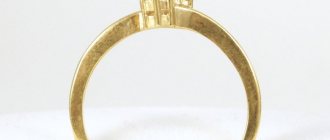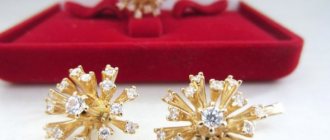What is white gold really?
Rhodium metallization: creating white gold from yellow
Rhodium is a rare metal that is very resistant to corrosion. We already know that white gold is plated with rhodium, but this metal can also be used to plate yellow gold to make it appear white. If you take your gold ring or other item to a jeweler, he will be able to plate it with rhodium for a fee.
Is it always easy to turn yellow gold into white gold? In reality, rhodium plating does not always work out as intended.
Problems with rhodium metallization during product processing
The biggest problem with rhodium plating is that you never know if the metal will stick to the surface of the piece. Whether a piece of jewelry can be plated with rhodium largely depends on the exact content of the alloy used in its manufacture. Some yellow gold alloys simply don't work out, and it's hard to tell in advance how successful the plating process will be.
Another problem is that the plating may not penetrate into the crevices of the jewelry. In this case, the product must be plated again. This problem is amplified if the jewelry has an intricate design with embellishments or different shapes that are resistant to plating.
How long does rhodium last on a product?
Like any coating, rhodium plating does not last forever. The metal softens over time, and the more often you wear your jewelry, the faster the rhodium layer will come off.
Additionally, each time your jewelry is professionally polished, the top layer is gradually removed by the polishing tools and the rhodium wears off, but you can always replate your jewelry with this metal.
Click here to view our collection of popular white gold jewelry.
Can rhodium plating be removed?
What if you don't like the look of your newly whitewashed gold? Is it possible to get rid of rhodium metallization? The answer is "Yes". You can ask a jeweler to remove the rhodium layer by polishing, then your jewelry will turn yellow again.
It doesn't matter whether you prefer yellow or white gold. Rhodium plating can be very useful if you want to see how your ring's gem would look in white gold but don't want to have to re-set it.
You can also cover only the teeth of your ring with metal. This is a good idea when you have a white diamond in a setting and you don't want the yellow prongs to ruin the color of the stone.
Source
Factors that hinder high-quality rhodium plating when making jewelry
The main difficulty with rhodium plating on gold is that there is no guarantee of how stable the metal will be on the surface of the jewelry. Whether metallization of jewelry is possible depends in most cases on the correct proportions of the alloy that was used in its production. It is difficult to estimate in advance the likelihood of successful rhodium plating of certain yellow gold alloys.
Another difficulty is that the rhodium plating is not always able to penetrate into the small holes of the jewelry. Under these circumstances, the decoration is subjected to re-plating. The problem is compounded by the complexity of the deposition process if the jewelry has intricate patterns.
White and regular yellow gold: which is more expensive, better and how they differ
Gold is a noble metal and relevant at all times. Depending on the weight of the jewelry and the complexity of its manufacture, everyone can choose a product that suits their pocket. But if before the classic yellow gold was the most common, now its various shades have taken their place on the market - white, pink, red, green, blue, black.
White gold is rightfully considered the most popular and valuable
. It will especially appeal to those who do not like yellow metal, but are considering purchasing gold jewelry. Such products are elegant, sophisticated and look great in combination with precious stones.
If color is not the primary criterion, then when choosing jewelry made of yellow or white gold, you need to keep in mind that their properties are somewhat different
. Each option has both its advantages and disadvantages.
Duration of the process and its cost
There are many factors that influence both the duration and cost of the process of melting scrap gold and making the finished jewelry. This includes the complexity of the product that the client orders, and the quality of the scrap gold to be melted down. Of course, the skill of the jeweler who will work with the product is not the least important.
On average, production time can vary from several hours - to melt a simple gold bar - and up to several months, if we are talking about jewelry with complex weaving and inserts of precious stones.
What is the difference between white gold and yellow gold?
Gold in its pure form has a bright yellow color, it is soft and easily deformed. Therefore, it is not used to make jewelry, but mixed with other metals - alloys
.
The composition and ratio of alloying elements in a gold alloy determine its color and other physical properties.
Thus, the differences between white gold and ordinary yellow gold are associated with the introduction of different components into their alloys. In most cases:
Sometimes alloys characteristic of yellow alloys are used for white alloys, and vice versa, to obtain the desired properties and shades of the metal.
To better understand the difference between these two types of gold, it is necessary to take a closer look at their characteristics.
How is the color of the alloy obtained?
The color of the yellow alloy is determined by the ratio of copper and silver content
in its composition. For example, the most common 585-carat gold has a bright and rich yellow color with almost the same content of alloying components - 22.75% Cu and 18.75% Ag. The less copper, the paler the shade. A further increase in its amount will lead to reddening of the material.
The white alloy is obtained by “bleaching” gold with an alloying metal
:
White gold alloyed with palladium or platinum is considered noble.
Both yellow and white gold can have zinc
. It helps to brighten the alloy.
Mechanical properties of alloys
To increase the hardness of yellow gold
use
copper
.
However, a large amount of it leads to a deterioration in the anti-corrosion properties of the alloy. To eliminate this drawback, silver
. It increases the ductility of the material and its resistance to corrosion.
As for white gold
, the addition of nickel, palladium or platinum to the composition makes it highly anti-corrosion.
Nickel
gives the alloy hardness and strength; such material is well polished.
But the compound with palladium
is softer. Angular, intricately ornate products from such an alloy are rarely made, since over time the corners can be smoothed out and lose their original appearance. However, such a material has good ductility.
It is believed that white gold wears better than yellow gold. It is harder and scratches less.
Platinum
makes the gold alloy not only harder, but also more elastic. This property is useful in the manufacture of complex jewelry and for the subsequent insertion of precious stones.
Possible allergic reactions
Gold itself is absolutely harmless to humans. It does not enter into chemical reactions with other substances. Another thing is metal alloys.
Nickel is the most common cause of allergic reactions.
, often found in white gold. That is why the use of such an alloy has been prohibited in Europe since 2000. It is, of course, advisable to choose products without this metal in the composition. As an option, you can consider jewelry not of 585 gold standard, but of 750 gold. If nickel does get into such an alloy, it is in much smaller quantities.
Copper is also an allergenic ligature.
and less commonly
zinc
. If gold jewelry, for example, a ring or chain, has darkened the skin, then this is a consequence of copper oxidation. This effect can appear both when the metal interacts with the external environment and with human skin (reaction to sweat). In such cases, it is also recommended to choose products made of 18-carat yellow gold, which contains less alloy.
The appearance of allergic reactions is now relevant for many people, so you should always pay attention to the composition of the gold alloy.
When purchasing jewelry with a high standard, you must keep in mind that a large amount of gold makes them soft and they are susceptible to external loads. Such products are more easily scratched and deformed, so you need to wear them with caution.
Allergies to nickel, which is used in large quantities in inexpensive jewelry, are much more common than to copper. Therefore, it is believed that from this point of view, white gold is more dangerous than yellow gold.
What is the price
Those who are thinking about what to do with a broken chain or bracelet should take into account that repairing an already finished item will be much cheaper. Therefore, you should not immediately run to the workshop. But if there are quite a lot of gold items in the house that cannot be restored, you can think about melting it down. Such jewelry includes earrings in one copy, heavily worn rings and pendants of Soviet models. It would actually be more profitable to melt them down or exchange them. Some jewelry shops and pawn shops offer scrap gold for exchange. This may be more profitable, but in this case you will have to choose a product from those already sold by this master.
Experts assure that it will be profitable to remelt only those products that weigh more than 10 g. There may be several of them, but the total weight should be quite large. Otherwise, you won’t be able to get a new product, because melting takes a lot of material.
As for how much it costs to melt gold, the price of such a procedure depends on what standard the jewelry is set to. Masters very rarely hire below 375. To obtain a beautiful thing, gold should not have many impurities. Melting 1 g of medium-grade precious metal will cost about 500 rubles. Therefore, you need to be prepared for the fact that you will have to pay 5000 just for 10 g. In the finished product you should expect at least 10% less gold than was originally handed over to the master. This amount is consumed by smelting and processing. In this case, no one is obliged to return the difference in weight.
Recently, many people have begun to purchase cheap gold jewelry from China. For their manufacture, a low-quality alloy is used, which most often cannot be remelted. Therefore, you should not expect that something else can be obtained from such a product.
What is more expensive: regular yellow gold or white gold?
With the same amount of gold in yellow and white alloys, their price will depend on the type of alloying elements and their percentage
.
Copper, nickel and zinc are base, inexpensive metals. In this case, the cost of yellow and white alloy will be approximately the same.
The price of white gold with the addition of palladium will be higher than with nickel. And finally, the most expensive alloy is with platinum. These are noble metals that are not cheap in themselves, especially platinum. In addition, working with these materials is more difficult than with conventional metals.
Due to the harmfulness of nickel, jewelry manufacturers are increasingly alloying gold with palladium or platinum, thereby increasing the cost of the white alloy.
Is it possible to make white gold from yellow gold?
There is an inexpensive way to make white gold from ordinary yellow gold - rhodium plating
. It consists of applying a very thin (several microns) layer of rhodium to the surface of the product.
Rhodium is a noble metal that belongs to the platinum group and is white in color. The decoration treated in this way acquires an ideal coating.
– smooth, shiny, without yellowness and other additional shades.
In addition, rhodium strengthens and strengthens the product. However, the coating has one significant drawback
- fragility. Over time, upon contact with the skin, the rhodium layer wears off, exposing the original alloy. This product loses its attractive appearance.
Source









